Japan
Wood Products Prices
Dollar Exchange Rates of 10th
Sep
2022
Japan Yen 142.58
Reports From Japan
Industrial output improves
again
Japan's industrial output in July grew 1% from the
previous month, the second consecutive month of increase.
The improvement was helped by an easing of parts
shortages following the relaxation of covid restrictions in
China.
The Ministry of Economy, Trade and Industry reported the
seasonally adjusted index of production stood at 97.1
against the 2015 base of 100. The July improvement
followed an upwardly revised increase of 9.2% in June.
In related news, the media have suggested that to revive
the Japanese economy the focus should be on the
profitability of small and medium size companies as these
are the biggest employers. There are 3.6 million small and
medium size companies in Japan, accounting for more
than 90% of all companies and employing 70% of the
workforce.
However, Japanese small and midsize companies are said
to have lower productivity than their overseas counterparts
and improving their productivity has been highlighted as a
major issue. In order to spread wage increases widely, it is
necessary for small and midsize companies to strengthen
their financial base.
See:
https://mainichi.jp/english/articles/20220831/p2g/00m/0bu/029000c
and
https://japannews.yomiuri.co.jp/editorial/yomiurieditorial/20220906-56447/
Pay rise eaten away by inflation
Workers in Japan saw increased take-home pay beginning
in July but the gains have been eroded by inflation. The
average monthly wage for July was around 375,000 yen,
up 1.8% from a year earlier in yen terms. Despite the gains
the average real wage dropped 1.3%, the fourth-straight
month of decline as increases in consumer prices outpaced
the pay rise.
Wholesale prices in Japan rose 9% in August from the
previous year, the same rate as in July, because of high
raw material costs which are being passed on. Against this
background and with consumer spending making up a
large part of GDP it is not surprising that the economy is
weakening.
See:
https://www3.nhk.or.jp/nhkworld/en/news/20220906_13/
Business investment signals optimism in near term
It came as a surprise to many that July core machinery
orders, which reflect company forecasts of the direction of
the economy, added to the increase seen in June. This is
encouraging as business spending will help offset the
current economic challenges from the global economic
slowdown and the weaker yen.
The increase in core orders, a barometer of capital
expenditure, could provide temporary relief for
policymakers hoping corporate investment will to spur
domestic consumption.
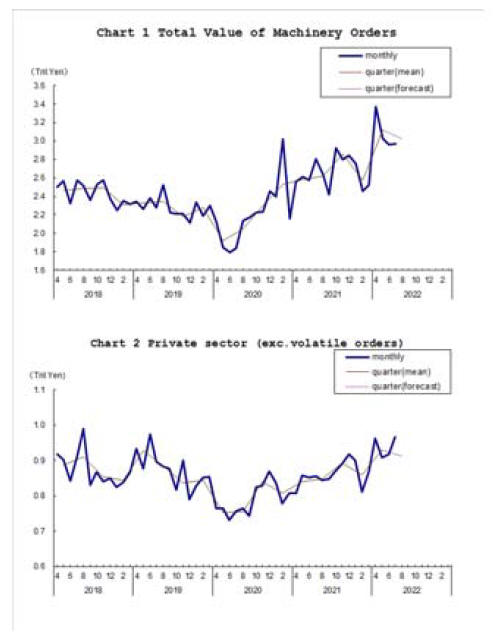
Source: Cabinet Office, Japan
Covid restrictions for arrivals may be eased
The government is considering further relaxing border
controls for incoming travellers as a way to boost the
economy through taking advantage of the weak yen to
attract visitors. The yen dropped to its lowest point against
the US dollar in 24 years recently at yen 142 to the US
dollar making Japan an attractive destination for tourists.
See:
https://pragativadi.com/japan-likely-to-relax-travelrestrictions-on-foreign-tourists-to-lift-economy/
Call for action on weak yen
Deputy Chief Cabinet Secretary, Seiji Kihara, has urged
action against the steep decline in the yen/dollar exchange
rate warning about the currency's decline to a 24-year low.
The yen weakness is the result of currency traders focus
on the widening divergence between the US interest rates
and the Bank of Japan's (BOJ) pledge to maintain ultralow
rates.
See:
https://www.ctvnews.ca/business/japan-must-take-stepsagainst-excessive-yen-moves-government-spokesman-1.6063926
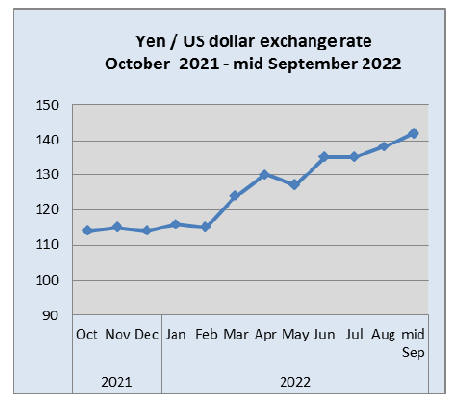
Renovate and let vacant homes
The number of vacant houses continues to rise even in
good locations in urban areas. But now owners can take
advantage of leasing services that renovate such homes
and let them as residences or shops.
The leasing service businesses can make a profit by
rehabilitating properties and transforming them into
income-producing assets on behalf of the owners. The
central government and local administrations are imposing
more measures to address the vacant home problem and
hope the growth of such leasing/renovation companies will
help reduce the number of empty homes.
See:
https://japannews.yomiuri.co.jp/business/companies/20220905-56015/
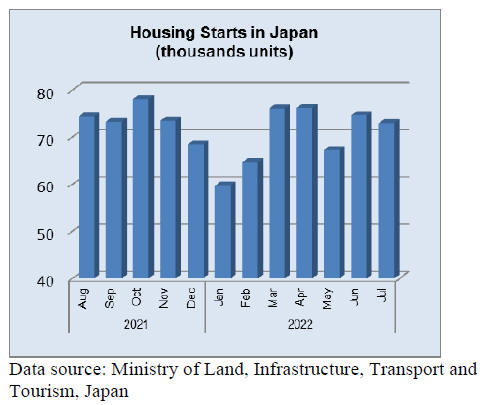
Furniture imports
For the first time in three months there was an up-tick in
the value of wooden kitchen furniture (HS940340)
imports. In contrastand for the first time in 2 month
imports of wooden bedroom furniture levelled off.
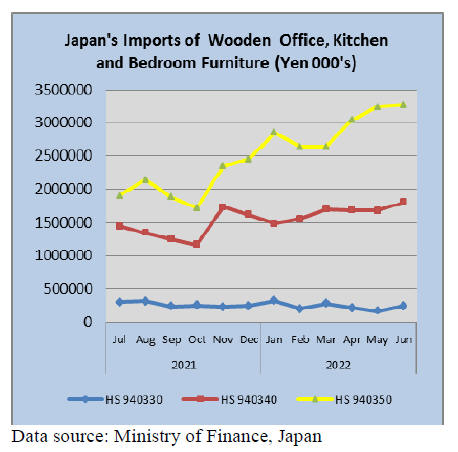
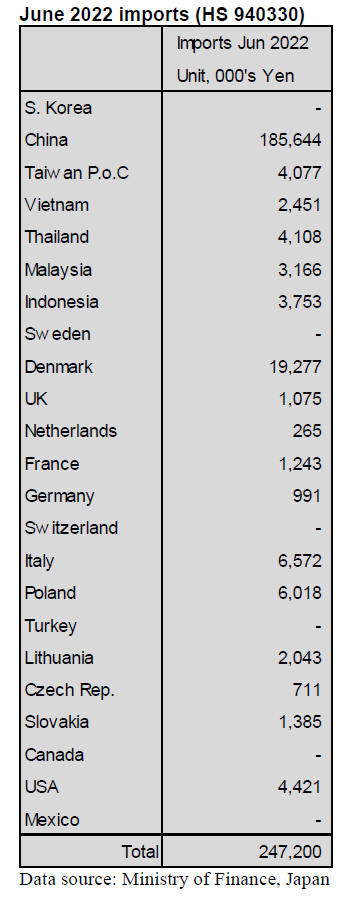
June office furniture imports (HS 940330)
Year on year the value of wooden office furniture imports
declined 20% in June but compared to a month earlier
there was an over 40% surge driven by increased
shipments from China which accounted for 75% of all
wooden office furniture and by a jump in imports from
Denmark.
For the first time shippers in Denmark have made it into
the list of top 20 shippers. Denmark accounted for around
8% of June arrivals followed by Italy and Poland at about
2.5% and Thailand, Malaysia and Indonesia at 1.5% each.

June kitchen furniture imports (HS 940340)
In June there was a 7% rise in the value of month on
month imports of wooden kitchen furniture and a
significant 21% increase in year on year imports.
The Philippines and Vietnam compete for the top spot in
wooden kitchen furniture deliveries to Japan and in June
each accounted for around 40% of all imports of
HS940340. The remaining 20% of the value of imports
was taken up by China (8%) and Thailand (7%). All of
these shippers of wooden kitchen furniture saw gains in
June compared to a month earlier.
June bedroom furniture imports (HS 940350)
As has been the case throughout the year shipments of
wooden bedroom furniture from manufacturers in China
accounted for the bulk of June arrivals (65%). The value
of June shipments from China was little changed from a
month earlier. Vietnam was the second largest shipper of
wooden bedroom furniture to Japan in June and accounted
for around 25% of all shipments. The other two shippers
of note in June were Malaysia and Indonesia.
Year on year, June shipments of wooden bedroom
furniture were up 31% but month on month the value of
June shipments was much the same as in May.
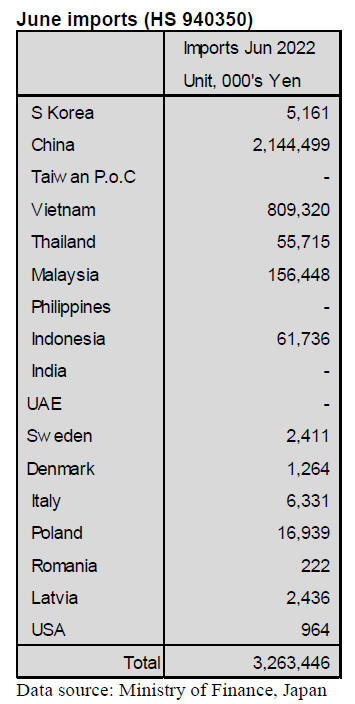
Trade news from the Japan Lumber Reports (JLR)
The Japan Lumber Reports (JLR), a subscription trade
journal published every two weeks in English, is
generously allowing the ITTO Tropical Timber Market
Report to reproduce news on the Japanese market
precisely as it appears in the JLR.
For the JLR report please see:
https://jfpj.jp/japan_lumber_reports/
Sojitz to transfer its business to a subsidiary company
Sojitz Corporation decided to transfer log import business
to a subsidiary company, Sojitz Building Materials
Corporation as of the 1st of October. There are several
reasons such as export restrictions in overseas, a shortage
of logs and less demand in Japan.The import log business
is at Forestry & Circular Business Development Dept. of
Sojitz Corporation.
There are ten people working and they import logs and
lumber from South Sea, Russia, New Zealand, and North
America. They also do business with domestic lumber.
They sell South Sea logs and lumber to plywood
companies or wholesalers in Japan. They used to import
Russian logs and larch veneers until last year but now they
are unable to import due to prohibited exporting logs and
veneers from Russia by an invasion in Ukraine by Russia.
There is no restriction on trading with New Zealand but
major lumber companies in Matsunaga in Hiroshima
prefecture do not need NZ logs much because they started
producing domestic logs instead.
Lumber companies, which use North American logs for
producing, withdrew and North American logs are sold to
wholesalers.
The import log business is not the only business but also
biomass and circular business at Sojitz Corporation. The
biomass business is about selling imported woodchips,
which are from Vietnam, PKS and pellets. The circular
development business is about developing biomass
business in Hokkaido prefecture, fast growing trees and
investment in forestry business in overseas.
Sojitz Building Materials Corporation will reorganize
formation in September to accept the import log business
from Sojitz Corporation. Sales of March, 2022 was about
197 billion yen, 35.7% more than last year and recurring
profit was about four billion yen, 398.5% more than last
year. Today, conglomerates concentrate on controlling
business such as investments, system developing and
transfer trading business to its subsidiary companies.
Trading companies controlled everything about lumber
and structural lumber by the head office at an early period
but in 1980*s, there was a winter era of trading companies.
Then, they changed the business style. Trading companies
import logs or lumber and building materials companies
sell those products. Now, it changed again, subsidiary
companies start importing logs too. There are no more
conglomerates which do integrated management for
selling imported logs in Japan.
A price hike on adhesive
Oshika Corporation raises prices over 10% on any type of
adhesive as of 21st August. This is the second time for
raising the prices in this year. It was in April for the first
time. A reason for this time is a price hike of crude oil and
natural gas caused by an invasion in Ukraine by Russia.
The future price of brent crude oil for a barrel is between
$90-100 and it is over $10 higher than the prices in
January, 2022. The prices of 1kg naphtha also increased to
86,000 yen in April to June from 60,000 yen in January to
May. Other production costs such as distribution cost or
subsidiary materials cost increased so the company had no
choice but raising the prices.
Log demand for the first half of the year
Logs for lumber manufacturing at the 1st half of 2022 are
8,639,000 cbms, 5.9% more than the same periods in
2021. For plywood manufacturing, an amount supplied is
3,045,000 cbms, 19.3% more. Production activities have
been lively since last year because the volume of imported
lumber decreased.
Domestic logs account for 80% out of 100% and supply
smoothly which make the prices lower than before.
However, if there were not enough logs due to the
damages by torrential rains, the prices would rise again. A
volume of domestic logs for lumber is 6,695,000 cbms,
7.2% more than the same periods in last year and of
imported logs for lumber is 1,944,000 cbms, 1.9% more.
Domestic logs occupy 77.5% of all and it is 0.9 point
increase. Domestic softwood log is 6,685M cbms, 8.4%
higher than the same periods in last year. Domestic
hardwood logs are 10,000 cbms, 87.7% lower. This is
because the prices of softwood logs were high so the
harvest is heavy to softwood.
The amount of consumption of logs for lumber is
8,252,000 cbms, 2.4% more than last year. Since the
supply is bigger than consumption, the inventory at the
end of June was 3,769.000 cbms, 12% more than June,
2021. This is increase for the first time in three years.
Domestic log for plywood is 2,751,000 cbms, 17.4%
increased from last year. Imported log for plywood is
294,000 cbms, 40.7% increased. A rate of domestic log is
90.3%, 1.5 points decrease. An amount of consumption of
logs for plywood is 2,630,000 cbms, 2.9% increased.
The inventory at the end of June was 823,000 cbms,
95.5% increased. It was double volume compared to
June, 2021. Orders by the manufacturers in Japan calmed
down because the amount of imported lumber increased in
January to June. There are enough logs at lumber and
plywood mills so inquires for domestic logs also slowed
down. However, the prices could soar if the heavy rain at
Tohoku and Hokuriku region in August affects the volume
of logs and the typhoon season is coming soon, which is
another concern.
Domestic lumber and logs
Demand and supply of domestic lumber is inactive
through the nation. The prices in Kanto region especially
weakened. However, the lumber does not move, even if
the prices are low. The prices of a cedar post, 3m x
105mm, are 90,000 yen, delivered per cbm. If this
movement continues after September, 90,000 yen would
be hard to maintain.
A movement has been inactive since June. A quantity
from some lumber plants to the markets stayed in same
volume in July and it decreased 10% in August. The sales
at the markets in Kanto region have been declining. The
time for auctions became an hour shorter than it used to be
before due to the terrible heat and buyers did not buy
much lumber. This movement of lumber influenced a
movement of domestic logs.
It has been slow since June or July. The prices of
domestic cedar and cypress logs decreased in every place
except Kyushu area and Akita prefecture. It is 18,000 每
20,000 yen for a 3m cedar log, delivered in Kyusyu area
and Akita prefecture. The prices in other regions are
15,000 每 16,000 yen, which are 1,000 每 2,000 yen lower
than last month. In some places, the prices decreased to
around 13,000 yen. The prices of 4m medium size logs are
12,000 每 13,000 yen.
However, some people expect that demand for logs would
be back as demand for lumber increases because it will be
a good season to harvest trees. A shipment of logs was
good for summer in this year and this movement made a
difference between a shipment of lumber and logs. Logs
cut in summer is not popular because of heavy moisture so
sawmills are not anxious to purchase summer logs that is
why the log market prices decreased.
Plywood
A shortage of domestic softwood plywood has settled
down. The situation is almost back to normal except in
Western Japan. There is still a shortage of long sized
plywood due to a fire at Nisshin Co., Ltd. in Tottori
prefecture. A reason for settled down is that structural
plywood from China arrived to Japan. However,
manufacturers* carry small inventory, which was 0.3
month, at the end of July.
There is no rush for selling the inventory because there are
still many orders. As manufacturers, it is better to keep the
inventory when a movement of plywood starts to be lively.
If the prices of domestic softwood plywood decreased in
the future, it would be possible to reduce production or
produce other plywood, like non- structural panels.
There is a different atmosphere in South East Asia and
Japan. Since other materials, logs and adhesive are highpriced
in South East Asia, 3 x 6 of plywood for concrete
forming is $850, C&F per cbm. It levels off since last
month.
There are no thoughts about lowering the prices because it
will be a rainy season in October and there will be less
logs until March, 2023 in South East Asia. A movement of
South Sea plywood at Japanese markets is dull.
Construction companies have enough inventory. In
distribution business, there is a shortage of plywood for
concrete forming so there is a need to get plywood even if
the movement is dull.
|